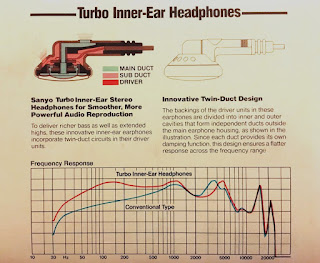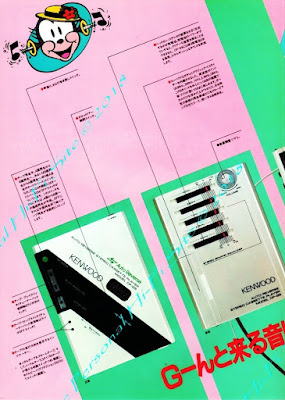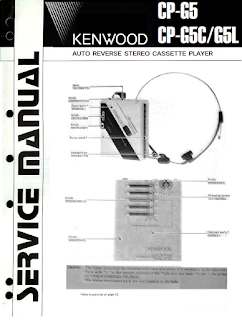~~ SANYO MR-JJ11 - 'Touch JJ' ~~
Auto-reverse Cassette Player with a Radio pack
Touch with you! Touch the sound! Touch JJ!
"It was an experience I had never seen before. I felt a sense of dancing rather than operating.
So now, I want my Touch JJ, touch operation"
The JJ Touch sound, anytime, anywhere, Touch JJ:
"I come to think that it is cute as a pet"
"I come to think that it is cute as a pet"
Remote Control
The useful Remote control can operate tape in the bar even if it is far away from you • Nice feeling operation with a full logic mechanism • Touch operation: when you only touch the button lightly • Touch volume: whose volume operation is also up-down • With the Remote control operation from the outside of your bag, you can play the direction and ON/OFF of the tape.
The 'Touch' JJ Remote Control - Basic tape operation
• When the unit power is turned off, a memory function remembers the volume state • The auto-reverse mechanism can be switched between endless mode and 1 way stop mode. In the endless mode, an auto-play function, if you perform fast forward or rewind, the song on the backside is automatically reverse at the end of the tape.
Tuner Pack
• TV/FM/AM - A 2 band in 1 tuner pack • Tuner pack adapter • 3-way auto-reverse mode • Full auto stop • Hold switch to keep an accidental operating safety
<<< The Review >>>
The unique MR-JJ11 was a very innovative model for its time: Sanyo, who present it as their business card - was ahead of its time. It was absolutely reflecting its title, what collectors call it: "The JJ Touch". Surprisingly, it is a very wise machine that can think for you because it has full Logic Control transmission + digitally controlled functions. Back then this was, in itself a very uncommon thing for any brand name to manufacture. You can tell this by its bulkiness, it is not slim but not fat either, and that is because, when they made it in late 1984 ("60•4•01" from the sticker on the motor) that was the available technology. Even though AIWA was collaborating with Sanyo to build such players like the AIWA HS-8 series, they both have big similarities between them internally and externally for that matter*.
However, how advanced they were, for some reason, people didn't buy the JJ11. Maybe because they thought it was "too expensive for such a toy". The truth is that this technology was very expensive to build in 1984 especially when you're using new advanced parts and features. It is more like a company's flagship to build such player - a milestone, a trademark, A Sanyo. (*see AIWA, Sanyo comparison)
The player has a very chic style, it has attention to details, ie the green/turquoise color, the full metal jacket - 300 grams of metal (90%), the large attractive window, even the die-cast JJ trademark letters are brushed metal on the only plastic triangle part... Transport is very smooth and quiet, it's a bit slow to enter play or reverse: a 2-millisecond delay which is common, but the Rewind and Fast Forward have instant response thanks to its simple transmission that is powered by 3V or 2 x AAA batteries. The mechanism is housed in metal construction and it's almost inaccessible, you'll have to do a lot of desoldering to access the mechanism. However, replacing the belt is as easy as 1-2-3. Some of the Special features that this player has: Power is only available if you plug in the headphones otherwise it won't work. Also, when the cassette door is opened the power cuts off. Another unique feature is the volume control which is a logic control and will reset itself to mid-level when removing the batteries for more than 5 min period.
The Sound quality is amazing, no matter how bulky it is, it sounds pure and warm without any sound enhancements. The volume is pretty high 15mW+15mW per channel. FM radio is very clear too and has a very good stereo separation, though the reception wasn't very sensitive because it lacks an internal antenna and it uses the headphone wire as the antenna. The provided earphones sound nice, equal highs and lows but the soundstage was too narrow. I wasn't really getting into testing their sound abilities although Sanyo praised them as "Turbo Inner-Ear Stereo Headphones" with these unique abilities, I didn't find them attractive enough.
The MR-JJ11 wasn't designed for carrying it with a belt clip; in that case, it will be very uncomfortable to operate such a player. Therefore, it is more handheld; however, it's a bit tiring to carry for more than an hour. You can't even put it in your pocket because it is too thick or wide so the only way to carry it is in your bag and use the remote control. The switches are big and sturdy; half of them I believe are made of metal. The Tuner pack dial is well under the surface to avoid accidentally interrupting radio reception (the same goes for all the other logic buttons).
In conclusion: The JJ Touch is a very impressive player considering its age and pioneering. As I've mentioned before this player is a milestone in headphones stereo and it is very hard to find. It is believed that it wasn't actually sold to consumers, rather it was a prototype model, therefore, it is very sought after by collectors and it is well worth the effort.
*AIWA HS-G8 and MR-JJ11 Comparison
The collaboration between SANYO and AIWA to build this prototype concept of such a player led them to build a unique player. There is a great similarity between these two players down to the fine details. The introduction date for both players is a year separated. During that period, Aiwa went further to develop its own style into that concept and managed to innovate it even further with an EQ while Sanyo remained with the tuner pack. This is the reason why the MR-JJ11 is bulky with its obsolete tuner pack which is an old concept that was first introduced by Toshiba. If you're looking from the outside it doesn't really appear that they are similar but on the inside, they are very much similar. As we start with the face-plate there are similar elements like the triangle brushed plastic and the Silver line on the side, they both open the door from the right side.
Now as we look at the inside the similarity is very noticeable and reveals how much they are alike.
Now as we look at the inside the similarity is very noticeable and reveals how much they are alike.
When we look at the transports they are identical;
· The motor is the same one.
· the main belt installs on the same path.
· Battery compartment on the right for 2 x AAA batteries.
· Open latch and the switches on the top left side.
· 2 I/O on top and the Feather-touch buttons as well.
The PCB layout on the AIWA is a little wider because of the Music Sensor circuit that the Sanyo lacks. The Aiwa also has the actual Volume potentiometer on the board while the JJ11 is a logic type. One more thing is that Aiwa designed the PCB for a slim fit; hence, most of the Caps and IC chips are layered on the bottom side of the PCB to fit well with the gear and transport. Unfortunately, the JJ11 chips and Flexi-wires are on top causing it to be thicker. Both players use identical gear parts and the same layout;
· 2 solenoids,
· 2 MD plungers,
· 2 Armlocks and
· The main drive parts; 'MD Cam' with the
'Select Cam changer'.
Sanyo also used many (6) and lengthy flexible-wires; for the motor, tuner pack, etc. while Aiwa used just 2; one for the Equalizer and a Flexi-wire for the head. An interesting thing is that on the JJ11 motor Flexi-wire is printed initial letters: AI which nowadays means: Artificial Intelligence. ;-)
Sanyo MR-JJ11 Disassembled
Specifications:
2 Tracks - Stereo
■ Frequency Range:
Normal 40 ~ 14,000Hz
Metal 40 ~ 16,000Hz
■ Output (EIAJ/DC):
Headphone output total:
15mW x 15mW = 30mW
■ Power source:
AC: through AC adapter/charge (D3-1000R).
DC: battery (AAA X2),
Optional: Car adapter (CBA-100R).
■ Battery Power:
(EIAJ music reproduction @ VOL. level 6)
About 7 hours (With Alkaline battery)
About 3.5 hr. (Sanyo Mallory Super)
■ Maximum external dimensions:
(W) 81.75 X, (H) 109 X, (D) 29.29mm
■ Weight:
Main body: Approx 288g,
Tuner Pack: 58g.
All rights reserved to
The Personal Hi-Fi Site © 2018
~~~~~~~





















































